Related Research Articles
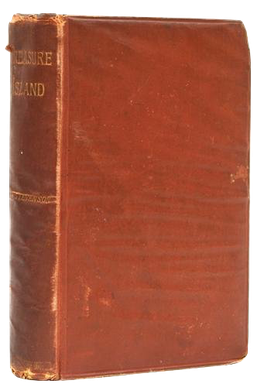
Treasure Island is an adventure novel by Scottish author Robert Louis Stevenson, telling a story of "buccaneers and buried gold". It is considered a coming-of-age story and is noted for its atmosphere, characters, and action.

Long John Silver is a fictional character and the main antagonist in the novel Treasure Island (1883) by Robert Louis Stevenson. The most colourful and complex character in the book, he continues to appear in popular culture. His missing leg and parrot, in particular, have greatly contributed to the image of the pirate in popular culture.

Pirates of the Caribbean is a dark ride at Disneyland, Walt Disney World's Magic Kingdom, Tokyo Disneyland, Disneyland Park at Disneyland Paris, and Shanghai Disneyland.
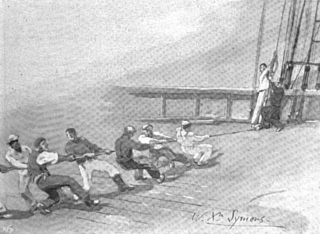
A sea shanty, chantey, or chanty is a genre of traditional folk song that was once commonly sung as a work song to accompany rhythmical labor aboard large merchant sailing vessels. The term shanty most accurately refers to a specific style of work song belonging to this historical repertoire. However, in recent, popular usage, the scope of its definition is sometimes expanded to admit a wider range of repertoire and characteristics, or to refer to a "maritime work song" in general.

Norman Island is an island at the southern tip of the British Virgin Islands archipelago. It is one of a number of islands reputed to be the inspiration for Robert Louis Stevenson's pirate novel Treasure Island.

Captain J. Flint is a fictional golden age pirate captain who features in a number of novels, television series, and films. The original character was created by the Scottish writer Robert Louis Stevenson (1850–1894). Flint first appears in the classic adventure yarn Treasure Island, which was first serialised in a children's magazine in 1881, and later published as a novel in 1883.
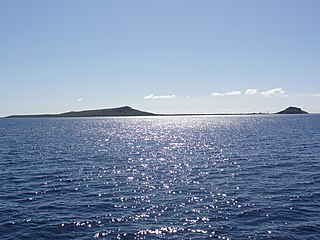
Caja de Muertos is an uninhabited island off the southern coast of Puerto Rico, in the municipality of Ponce. The island and its surrounding waters are protected by the Caja de Muertos Nature Reserve, because of its native turtle traffic and ecological value of its dry forests and reefs. Hikers and beachgoers are often seen in the island, which can be reached by ferry from the La Guancha Boardwalk sector of Ponce Playa. Together with Cardona, Ratones, Morrillito, Isla del Frio, Gatas, and Isla de Jueyes, Caja de Muertos is one of seven islands ascribed to the municipality of Ponce.
Derelict may refer to:

Dead Chest Island is an island located half a mile north east of Deadman's Bay on Peter Island, British Virgin Islands. It is uninhabited, has no fresh water or trees and only sparse vegetation. It was formerly used as a firing range by the Royal Virgin Islands Police, but the opening of the nearby hotel on Peter Island coincided with the decision to build a proper firing range on the island of Tortola. The island is now an uninhabited National Park, with several popular scuba diving and snorkeling sites.
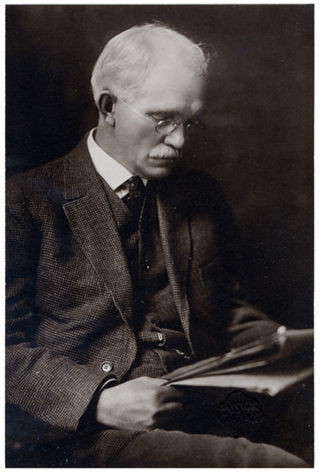
Young Ewing Allison (1853–1932) was an American writer and newspaper editor.
"Yo Ho (A Pirate's Life for Me)" is the theme song for the Pirates of the Caribbean attractions at Disney theme parks. The music was written by George Bruns, with lyrics by Xavier Atencio. The version heard at Disneyland and Walt Disney World's Magic Kingdom was sung by the Mellomen, featuring Thurl Ravenscroft.

A treasure map is a map that marks the location of buried treasure, a lost mine, a valuable secret or a hidden locale. More common in fiction than in reality, "pirate treasure maps" are often depicted in works of fiction as hand drawn and containing arcane clues for the characters to follow. Regardless of the term's literary use, anything that meets the broad definition of a "map" that describes the location of a "treasure" could appropriately be called a "treasure map."
Pirates of the Caribbean is a Disney media franchise encompassing numerous theme park rides, a series of films, and spin-off novels, as well as a number of related video games and other media publications. The franchise originated with Walt Disney's theme park ride of the same name, which opened at Disneyland in 1967 and was one of the last Disneyland attractions overseen by Walt Disney. Disney based the ride on pirate legends, folklore and novels, such as those by Italian writer Emilio Salgari.

Buccaneer Bunny is a 1948 Looney Tunes cartoon directed by Friz Freleng. The short was released on May 8, 1948, and features Bugs Bunny and Yosemite Sam.

In English-speaking popular culture, the modern pirate stereotype owes its attributes mostly to the imagined tradition of the 18th-century Caribbean pirate sailing off the Spanish Main and to such celebrated 20th-century depictions as Captain Hook and his crew in the theatrical and film versions of J. M. Barrie's children's book Peter Pan, Robert Newton's portrayal of Long John Silver in the 1950 film adaptation of the Robert Louis Stevenson novel Treasure Island, and various adaptations of the Middle Eastern pirate, Sinbad the Sailor. In these and countless other books, films, and legends, pirates are portrayed as "swashbucklers" and "plunderers". They are shown on ships, often wearing eyepatches or peg legs, having a parrot perched on their shoulder, speaking in a West Country accent, and saying phrases like "Arr, matey" and "Avast, me hearty". Pirates have retained their image through pirate-themed tourist attractions, film, toys, books and plays.

Piracy in the British Virgin Islands was prevalent during the so-called "Golden Age of Piracy", mainly during the years of 1690-1730. Privateering was also widely practised in the jurisdiction throughout frequent colonial wars, not least by emancipated slaves who, with in preference to back-breaking labour in the fields for pitiful wages, took enormous risks to capture fortunes on the seas with the sanction of the Crown. In 1808, Patrick Colquhoun, a prize agent for the Territory spoke of "the most daring outrages which are frequently committed by people of colour."

Billy Bones is a fictional character appearing in the first section of Robert Louis Stevenson's 1883 novel Treasure Island.
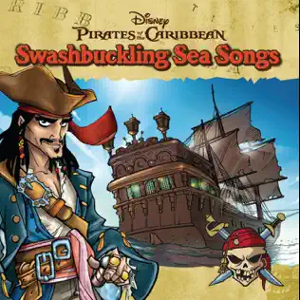
Disney's Pirates of the Caribbean: Swashbuckling Sea Songs was released on CD in 2007, as part of a CD/DVD combo pack, packaged with Pirates of the Caribbean: Dead Man's Chest, and offered at Wal-Mart stores. The CD contained the following 14 tracks, by Various Artists.
- Away, Away, Away (2:45)
- Treasure (2:06)
- The First Mate Is a Monkey (2:28)
- Welcome to the Caribbean (2:57)
- Stowaway Listen Listen (2:41)
- The Legend of Davy Jones (3:41)
- Shiver My Timbers (2:18)
- Yo, Ho, Ho (2:01)
- Sailing for Adventure (2:33)
- Blow the Man Down (2:51)
- The Pirate King (2:22)
- Pirates of the Black Tide (3:10)
- Davy Jones' Locker (2:33)
- Yo Ho (5:43)

Treasure Island is a 1920 silent film adaptation of the 1883 novel by Robert Louis Stevenson, directed by Maurice Tourneur, and released by Paramount Pictures. Lon Chaney played two different pirate roles in this production, "Blind Pew" and "Merry", and stills exist showing him in both makeups. Charles Ogle, who had played Frankenstein's Monster in the first filmed version of Frankenstein a decade earlier at Edison Studios, portrayed Long John Silver. Wallace Beery was supposed to play Israel Hands, but that role went to Joseph Singleton instead. The film was chosen as one of the Top Forty Pictures of the Year by the National Board of Review.
References
Notes
- ↑ Fictional sea-song - in this sense means a sea-song that first appeared in a work of fiction, and not an authentic sea song; however, this does not mean the song was not later sung in real life by real sailors. For a full treatment of the fictional origin of the song, "wholly original with Stevenson", see Starrett, Vincent (1923). Buried Caesars. AMS Press. pp. 189–204. ISBN 9780404062231.
- ↑ Many sources call "Dead Man's Chest" a sea chanty, however Stevenson himself never called it that, rather the novel says it's a "sea-song" and a "sailor's song". Sea-song is described in the Oxford English Dictionary as "A song such as is sung by sailors." (sea-song, n.; Second edition, 1989). The OED defines shanty as "A sailor's song, esp. one sung during heavy work." The OED has no entry for sailor's song. Since the terms Stevenson used are oblique, it is a matter of interpretation if Stevenson meant it to be a shanty, or not.
- ↑ The relevant quote from At Last
the first of those numberless isles which Columbus, so goes the tale, discovered on St. Ursula's day, and named them after the Saint and her eleven thousand mythical virgins. Unfortunately, English buccaneers have since then given to most of them less poetic names. The Dutchman's Cap, Broken Jerusalem, The Dead Man's Chest, Rum Island, and so forth, mark a time and a race more prosaic, but still more terrible, though not one whit more wicked and brutal, than the Spanish Conquistadores
Citations
- 1 2 3 Schraer, Erich. "Derelict". biostat.wustl.edu. Washington University in St. Louis. Archived from the original on 2006-09-14. Retrieved 2021-11-21.
- 1 2 3 Hersey, Frank Wilson Cheney (1911). Stevenson's Treasure Island. Boston: Ginn. pp. 214–215.
…the Dead Man's Chest is the name of one of the Virgin Islands in the West Indies.
Note: Hersey incorrectly says Stevenson derived the song from Billy Bones's Fancy, rather Billy Bones's Fancy is derived from Stevensons original chorus in Treasure Island. - ↑ There is also a Dead Man's Chest Island in Puerto Rico, not one of the Virgin Islands but close to them, and with the same name.
- ↑ Kingsley, Charles (1871). "Chapter 1: Outward Bound". At Last: A Christmas in the West Indies – via Project Gutenberg.
Unfortunately, English buccaneers have since then given to most of them [islands] less poetic names. The Dutchman's Cap, Broken Jerusalem, The Dead Man's Chest, Rum Island, and so forth, mark a time and a race more prosaic, but still more terrible, though not one whit more wicked and brutal, than the Spanish Conquistadores.
- 1 2 Cordingly, David (1996). Under the Black Flag: The Romance and the Reality of Life Among the Pirates. Random House. p. 5. ISBN 9780679425601.
- ↑ Stevenson, Robert Louis (2001). "To Sidney Colvin. Late May 1884". Selected Letters of Robert Louis Stevenson. New Haven: Yale Nota Bene. p. 263. ISBN 9780300091243.
- ↑ "Fifteen men on the Dead Man's Chest by Robert Louis Stevenson". Poetry Foundation. 2021-11-20. Archived from the original on 2018-10-05. Retrieved 2021-11-21.
- ↑ Hitchcock, Champion Ingraham (2006) [1914]. "The Dead Men's Song: Being the Story of a Poem and a Reminiscent Sketch of its Author Young Ewing Allison". Archived from the original on 2012-05-09. Retrieved 2021-11-21– via Project Gutenberg.
- 1 2 3 4 5 6 7 Starrett, Vincent (1923). Buried Caesars: Essays in Literary Appreciation. Books for Libraries Press. pp. 189–204. ISBN 9780836909029.
- ↑ "Jan Fedder - 17 Mann auf des toten Mannes Kiste" on YouTube
- ↑ "Stalin-17 Mann auf des Totenmannskiste" on YouTube